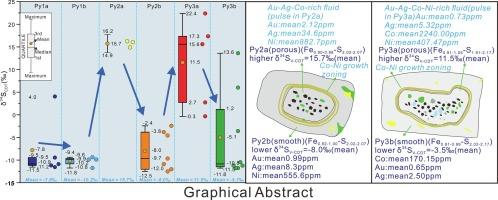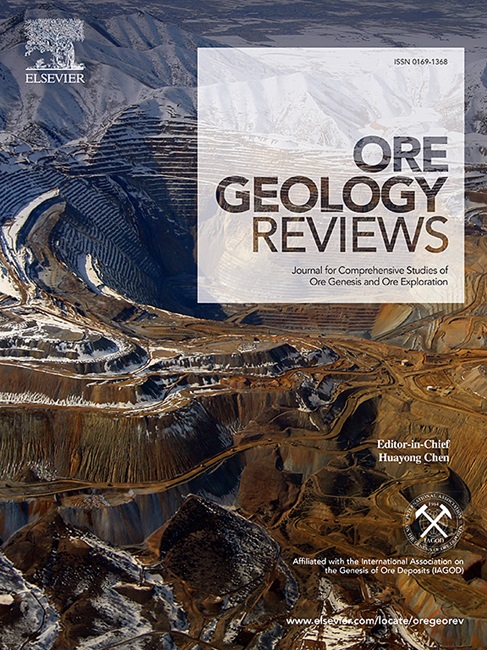Episodic fluid pulses in the Baiyun gold deposit, Liaodong Peninsula, Eastern China: Insights from in-situ trace elements, sulfur isotopes, and texture characteristics of pyrite
IF 3.6
2区 地球科学
Q1 GEOLOGY
引用次数: 0
Abstract
The driving mechanism behind the mineralization process remains ambiguous, whether it is propelled by a single fluid evolution or multiple fluid pulses. Minerals have the capacity to precisely document the fluid evolution. Hence, an accurate understanding of mineral formation is essential for a precise interpretation of fluid evolution. The Baiyun gold deposit is located in the Qingchengzi ore field in the Liaodong Peninsula of the North China Craton. The textural characteristics and geochemical composition of pyrite provide evidence for the formation process of the Baiyun gold deposit. Based on mineral assemblages, ore textures, and cross-cutting relationships, the Baiyun gold deposit can be divided into four stages: (I) disseminated/stockworked quartz-pyrite-K-feldspar, (II) quartz-pyrite-chalcopyrite-native gold vein, (III) quartz-pyrite-native gold ± galena ± sphalerite vein, and (IV) ore-barren calcite-quartz veinlets.
Native gold predominantly accumulates in stages II-III, each subdivided into two generations (Py2a, Py2b, Py3a, Py3b), with significant gold precipitation in the later Py2b and Py3b. Notably, Py2a displays high concentrations of As (avg. 412.66 ppm), Au (avg. 2.12 ppm), Ag (avg. 34.65 ppm), Co (avg. 471.88 ppm) and Te (avg. 39.79 ppm), contrasting with lower concentrations in Py2b for As (avg. 100.11 ppm), Au (avg. 0.99 ppm), Ag (avg. 8.33 ppm), Co (avg. 281.28 ppm) and Te (avg. 11.11 ppm). Stage III compares to stage II, with elements like Co (Py3a: avg. 2240.00 ppm; Py3b: avg. 170.15 ppm), Au (Py3a: avg. 0.74 ppm; Py3b: avg. 0.65 ppm), Ag (Py3a: avg. 5.33 ppm; Py3b: avg. 2.50 ppm), and As (Py3a: avg. 1132.91 ppm; Py3b: avg. 245.90 ppm) exhibiting similar trends of change. The δ34S value trend (Py2a → Py2b: avg. 15.7 ‰ → avg. −8.0 ‰; Py3a → Py3b: avg. 11.5 ‰ → avg. −3.4 ‰) aligns with the trace element variations. Thermodynamic simulations, based on mineral compositions and sulfur isotopes, reveal difference fluid natures between Py2a (T = 300 °C; pH = 5.1–6.5; moderate fO2 = −33.1 to −31.1) and Py3a (T = 250 °C; pH = 5.6–6.6; lower fO2 = −39.2 to −36.1). Noteworthy differences exist not only in trace elements and sulfur isotopes between stages II-III but also in the micro-deformation of pyrite. Stage II is marked by plastic deformation (dominated by low-angle boundaries; 2–5°), resulting in a non-significant contribution to gold precipitation. In contrast, stage III exhibits brittle deformation (dominated by high-angle boundaries; >5°), where gold primarily precipitates and enriches. The significant variations in trace elements, sulfur isotopes, fluid natures, and pyrite deformation indicate the occurrence of episodic fluid pulses. Furthermore, sulfur isotopes display both enrichment and depletion characteristics. This phenomenon may be related to sulfate reduction. The Paleoproterozoic strata serve as significant sulfur reservoirs within the region and could potentially serve as the principal source of sulfur.

中国东部辽东半岛白云金矿床的偶发性流体脉冲:从原位痕量元素、硫同位素和黄铁矿质地特征得出的启示
矿化过程背后的驱动机制仍不明确,究竟是由单一流体演化推动,还是由多个流体脉冲推动。矿物能够精确记录流体演化过程。因此,准确理解矿物的形成对于精确解释流体演化至关重要。白云金矿床位于华北克拉通辽东半岛的青城子矿田。黄铁矿的纹理特征和地球化学组成为白云金矿床的形成过程提供了证据。根据矿物组合、矿石质地和横切关系,白云金矿床可分为四个阶段:(I) 散生/块状石英-黄铁矿-长石,(II) 石英-黄铁矿-黄铜矿-原生金脉,(III) 石英-黄铁矿-原生金±方铅矿±闪锌矿脉,(IV) 矿石贫瘠的方解石-石英脉。原生金主要积聚在第二至第三阶段,每个阶段又分为两代(Py2a、Py2b、Py3a、Py3b),后期的 Py2b 和 Py3b 有大量金沉淀。值得注意的是,Py2a 显示出高浓度的砷(平均值为百万分之 412.66)、金(平均值为百万分之 2.12)、银(平均值为百万分之 34.65)、钴(平均值为百万分之 471.88)和碲(平均值为百万分之 39.79)。79 ppm),而 Py2b 中的砷(平均值为 100.11 ppm)、金(平均值为 0.99 ppm)、银(平均值为 8.33 ppm)、钴(平均值为 281.28 ppm)和碲(平均值为 11.11 ppm)浓度较低。第 III 阶段与第 II 阶段相比,钴(Py3a:平均值为 2240.00 ppm;Py3b:平均值为 170.15 ppm)、金(Py3a:平均值为 0.74 ppm;Py3b:平均值为 0.65 ppm)、银(Py3a:平均值 5.33 ppm;Py3b:平均值 2.50 ppm)和砷(Py3a:平均值 1132.91 ppm;Py3b:平均值 245.90 ppm)的变化趋势相似。δ34S值的变化趋势(Py2a → Py2b:平均值 15.7 ‰ → 平均值 -8.0‰;Py2a → Py2b:平均值 15.7 ‰ → -8.0‰)。-8.0 ‰;Py3a → Py3b:平均值 11.5 ‰ → 平均值 -3.4 ‰对齐。-3.4‰)与微量元素变化一致。根据矿物成分和硫同位素进行的热力学模拟显示,Py2a(T = 300 °C;pH = 5.1-6.5;中等 fO2 = -33.1 至 -31.1)和 Py3a(T = 250 °C;pH = 5.6-6.6;较低 fO2 = -39.2 至 -36.1)的流体性质不同。值得注意的是,第二至第三阶段之间不仅在微量元素和硫同位素方面存在差异,而且在黄铁矿的微变形方面也存在差异。第二阶段的特征是塑性变形(以低角度边界为主;2-5°),导致金析出不明显。相比之下,第三阶段表现为脆性变形(以高角度边界为主;>5°),金主要在此析出和富集。微量元素、硫同位素、流体性质和黄铁矿变形的显著变化表明发生了偶发性流体脉冲。此外,硫同位素显示出富集和贫化两种特征。这种现象可能与硫酸盐还原有关。古近纪地层是该地区重要的硫储层,有可能成为硫的主要来源。
本文章由计算机程序翻译,如有差异,请以英文原文为准。
求助全文
约1分钟内获得全文
求助全文
来源期刊

Ore Geology Reviews
地学-地质学
CiteScore
6.50
自引率
27.30%
发文量
546
审稿时长
22.9 weeks
期刊介绍:
Ore Geology Reviews aims to familiarize all earth scientists with recent advances in a number of interconnected disciplines related to the study of, and search for, ore deposits. The reviews range from brief to longer contributions, but the journal preferentially publishes manuscripts that fill the niche between the commonly shorter journal articles and the comprehensive book coverages, and thus has a special appeal to many authors and readers.
 求助内容:
求助内容: 应助结果提醒方式:
应助结果提醒方式:


